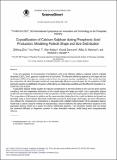Crystallization of Calcium Sulphate During Phosphoric Acid Production: Modeling Particle Shape and Size Distribution
Author(s)
Samrane, Kamal; Zhu, Zhilong; Peng, You; Hatton, Trevor Alan; Myerson, Allan S.; Braatz, Richard D; ... Show more Show less
DownloadBraatz_Crystallization of Calcium.pdf (547.9Kb)
PUBLISHER_CC
Publisher with Creative Commons License
Creative Commons Attribution
Terms of use
Metadata
Show full item recordAbstract
A key unit operation in the production of phosphoric acid is the filtration needed to separate calcium sulphate dihydrate (CaSO₄·2H₂O, gypsum) crystals from an acid slurry. The filtration efficiency depends on the shape and size distribution (SSD) of the gypsum crystals produced from the upstream reactive crystallization. This article describes the construction of a first-principles model and computationally efficient numerical solver for the prediction of SSD during the reactive crystallization of gypsum while taking non-ideal phase equilibria and the effects of impurities (i.e., metal ions) into account.
A population balance model couples the impurity compositions in the feed streams to the SSD for given process conditions, with the independent dimensions of the crystals being their length and width. Such a population balance model with two independent dimensions is able to represent rod-like crystals with varying aspect ratios (length/width). The compositions of all species in solution and the supersaturation driving force for crystal nucleation and growth are described using a mixed solvent electrolyte model that accounts for long-range, short-range, and ionic interactions. OLI software for computing the compositions is integrated with a Matlab implementation of the population balance model that is solved using the method of characteristics, which transforms the partial differential equations of the population balance model into a system of ordinary differential equations. This simulation method does not exhibit the numerical diffusion or dispersion common in other simulation methods, while being more computationally efficient.
The crystal nucleation and growth rates are measured in a series of mixed-suspension mixed-product-removal experiments of various acid concentration, temperature, and impurity levels. A variety of models for the effects of impurities on the growth rates along the width and length dimensions are compared in terms of their ability to describe experimental observations.
Keywords
phosphoric acid
particle shape
crystallization
population balance models
gypsum
Date issued
2016-03Department
Massachusetts Institute of Technology. Department of Chemical EngineeringJournal
Procedia Engineering
Publisher
Elsevier
Citation
Zhu, Zhilong; Peng, You; Hatton, T. Alan; Samrane, Kamal; Myerson, Allan S. and Braatz, Richard D. “Crystallization of Calcium Sulphate During Phosphoric Acid Production: Modeling Particle Shape and Size Distribution.” Procedia Engineering 138 (March 2016): 390–402 © 2016 The Authors
Version: Final published version
ISSN
1877-7058